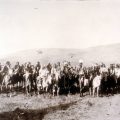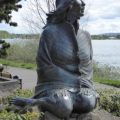During the nineteenth century, the United States had attempted to settle all Indians on well-defined reservations on lands deemed unsuitable for non-Indian development. Here Indians were to remain until they became extinct or had fully assimilated into the Christian American lifestyle. By the end of the nineteenth century, the government began the process of dismantling Indian reservations and increasing the pressures to assimilate. During the early twentieth century, for example, the United States had dissolved all of the tribal governments in Oklahoma so that the territory could become a state. By 1917, a majority of Indians still lived on reservations where they were considered wards of the government. In general, the reservations were pockets of poverty with poor health care and few educational opportunities. Briefly described below are a few of the events of 1917 which are related to Indian reservations and tribes.
Creek
In Oklahoma, Creek Principal Chief Moty Tiger resigned and George Washington Grayson was named by the President as the new Principal Chief. The position of Principal Chief at this time was viewed by the U.S. government as just another federal position. Grayson was required to fill out a personnel form noting his level of experience. He writes:
“Having been born and reared among the Creeks of the full-blood class, and been in intimate relations with them all these years, I believe I have an all-round knowledge of them that enables me to understand and manage them better than some others”
Chippewa-Cree
In Montana, Congressional action created the Rocky Boy Reservation for the Chippewa and Cree.
Hopi
In Arizona, a news service cameraman defied the rule against taking motion pictures of the Hopi Snake Dance. He was chased through the desert and his camera confiscated. After reporting the incident to the Commissioner of Indian Affairs, superintendent Leo Crane was told that the ban on photography should be allowed to continue.
In Arizona, the superintendent for the Hopi recommended that the name of the reservation be changed from Moqui to Hopi as the term “Moqui” is offensive to the Hopi.
Tohono O’odham
In Arizona, a compromise was reached regarding a reservation for the Tohono O’odham. President Woodrow Wilson issued an executive order that cut the reservation into two parts. The reservation would come to encompass 4,500 square miles. According to anthropologist Rosamond Spicer, in an essay in The Desert People:
“With all their lands thus formally designated as a reservation, the Papago acquired the rights, protection, and inconveniences with which most other Indians in the United States had long since been acquainted.”
The boundary line for the reservation, however, excludes the eastern slope of Boboquivari Mountain, one of their most sacred areas. Historian Eric Meeks, in an article in Western Historical Quarterly, writes:
“Central to the defense of the reservation was the understanding that increasing numbers of O’odham would participate in the expanding wage economy, either to supplement other economic activities, or to replace them.”
Cocopah
In Arizona, the federal government gave the Cocopah under the leadership of Frank Tehana three small areas of land (466 acres) as a reservation. The reservation was created by Executive Order. Anthropologist Anita Alvarez de Williams, in the Handbook of North American Indians, reports:
“This was the last time that the Cocopa were to hear from the national government for a long time. Culturally and linguistically isolated, ordinary school systems hardly touched them, and generally they responded to the rapidly expanding non-Indian community by withdrawing from it.”
Seminole
In Oklahoma, a number of Seminole leaders, including Ahullukay Tanyan, Nina Tanyan, Isaac Jones, Waxey Tanyan, and Sever Punaha, discussed the possibility of moving to the Mexican state of Coahuila. They claimed that the Seminole still had a land grant in the area because a band of Seminole under Wild Cat had lived there in the nineteenth century.
Wild Cat and about 300 Seminole had moved to Mexico in 1849. The Mexican government recruited the Seminole to fight against the Apache, Comanche, and Kiowa who crossed the border to raid in Mexico. As a reward for their services, the Mexican government had given them an initial land grant of 70,000 acres in Coahuila. Later they were given a larger reservation near Piedras Negras. After 1856 the Seminole began to drift back to the United States.
In Florida, the state transfered 99,200 acres in Monroe County to the Board of Commissioners of State Institutions for the perpetual use and benefit of the Seminole. Historian James Covington, in his book The Seminoles of Florida, reports:
“Few Seminoles took advantage of the state land reserved for them, for they did not want to be confined to a reservation, and the state was not willing to spend much money on it.”
Salt River Reservation
The superintendent of the Salt River Reservation in Arizona complained about four Yavapai-Apache leaders who were under the influence of Dr. Carlos Montezuma. He charged the four with a variety of offenses, including holding a meeting without his permission and accepting the advice of outsiders. He threatened to jail them for 30 days for refusing to accept the authority of the Commissioner of Indian Affairs.
Pine Ridge Reservation
In South Dakota, the council of traditional chiefs of the Oglala Sioux of the Pine Ridge Reservation had a disagreement with the Indian agent. In retaliation, the agent dissolved the council.
Rosebud Reservation
In South Dakota, a traditional Lakota chief, encouraged by the Lakota physician Charles Eastman, requested a council to discuss the Black Hills claim. The superintendent of the Rosebud Reservation recommended that the council be denied as the young men in such a council would not be likely to oppose the opinions of the elders. The Commissioner of Indian Affairs denied permission for the council.
Omaha
The Supreme Court found that Omaha land allotted under the 1865 treaty was only permission to occupy the land and that allotments under the 1882 Omaha Allotment Act superseded this.
Washo
In Nevada, a rancher donated 40 acres to the Washo which became the only land owned by the Washo people as a whole.
Ute
In Utah, special investigator Major James McLaughlin traveled to Montezuma Canyon to talk with the Utes in the area. He found about 160 Ute in Montezuma Canyon and about another 50 around Bluff. All were enrolled at the Ute Mountain Agency but refused to live on the reservation. The primary leaders were John Benow, George Brooks, and Polk. After talking with the American settlers in the area, McLaughlin concluded that the solution was to remove the Indians to the reservation.
In Utah, Ute leader Polk and his son Tse-Na-Gat went to a trading post to redeem a belt. While there was a conflict over the value of the belt, the trader acquiesced to Polk. A few days later, there was another conflict which resulted in the two men being thrown out of the trading post. Fearing retribution, the trader moved out of the area and reported the incidents to the sheriff in Monticello.
Goshute Reservation
In Utah, the Deputy Special Officer for the Suppression of Liquor Traffic visited the Goshute Reservation and was told to leave by Annie’s Tommy and Willie Ottogary. According to historian Richard Ellis, in an article in the Nevada Historical Society Quarterly:
“Apparently the agent considered the two men to be troublemakers and wanted them arrested.”
There was a scuffle and the agent was detained. Upon his release, the agent organized a posse and sent a telegram requesting troops. His telegram stated:
“Indians at Ibpah in revolt…Indians sending messengers over state and Nevada, bringing in other Indians. All have rifles”
The Commissioner of Indian Affairs responded by sending one man, an experienced investigator. The investigator found the situation at the agency to be peaceful. Richard Ellis reports:
“However, he also found a strong undercurrent of discontent along with outspoken demands for the removal of the superintendent.”
The investigator also lectured the Indians about the need to register for the draft even though they were not citizens. He then recommended that Annie’s Tommy, Willie Ottogary, and Al Steele be arrested for interfering with the draft registration of tribal members. All of the eligible men left the reservation for Nevada under the pretense of shearing sheep. No Gosiutes registered.
Chitimacha
In Louisiana, the Chitimacha received federal recognition.
Fort Peck Reservation
In Montana, the Fort Peck Reservation (Assiniboine and Sioux) was opened for non-Indian homesteading. Lands not allotted to tribal members were opened up.
Kiowa, Comanche, Plains Apache
In Oklahoma, the Indian Agent refused to recognize the Kiowa, Comanche, and Plains Apache Business Committee. The Business Committee had been originally formed in the 1890s and was composed of the principal chiefs of the three tribes. It had no defined authority but had some say in the dispersal of joint resources.
Fort Hall Reservation
In Idaho, the Shoshone and Bannock of the Fort Hall Reservation sent Garfield Pocatello and Philip Lavatta to Washington, D.C. to discuss leasing with government officials. One of their concerns was the practice of leasing Indian land for considerations other than cash because the lessees often failed to meet the terms of the lease. They also resented their inability to control revenues derived from cash leases.
Cherokee
In Oklahoma, Cherokee principal chief William C. Rogers died at the age of 67. Following the death of principal chief William C. Rogers, Congress authorized the President to appoint the Cherokee chief. Many of these new chiefs were appointed for only one day.



Leave a Reply